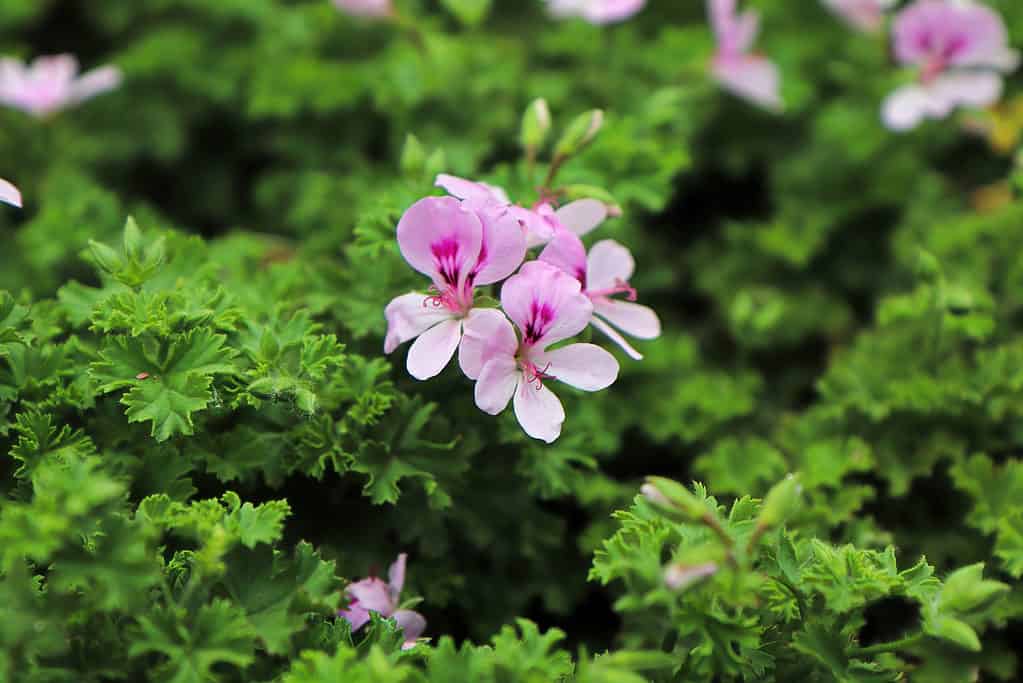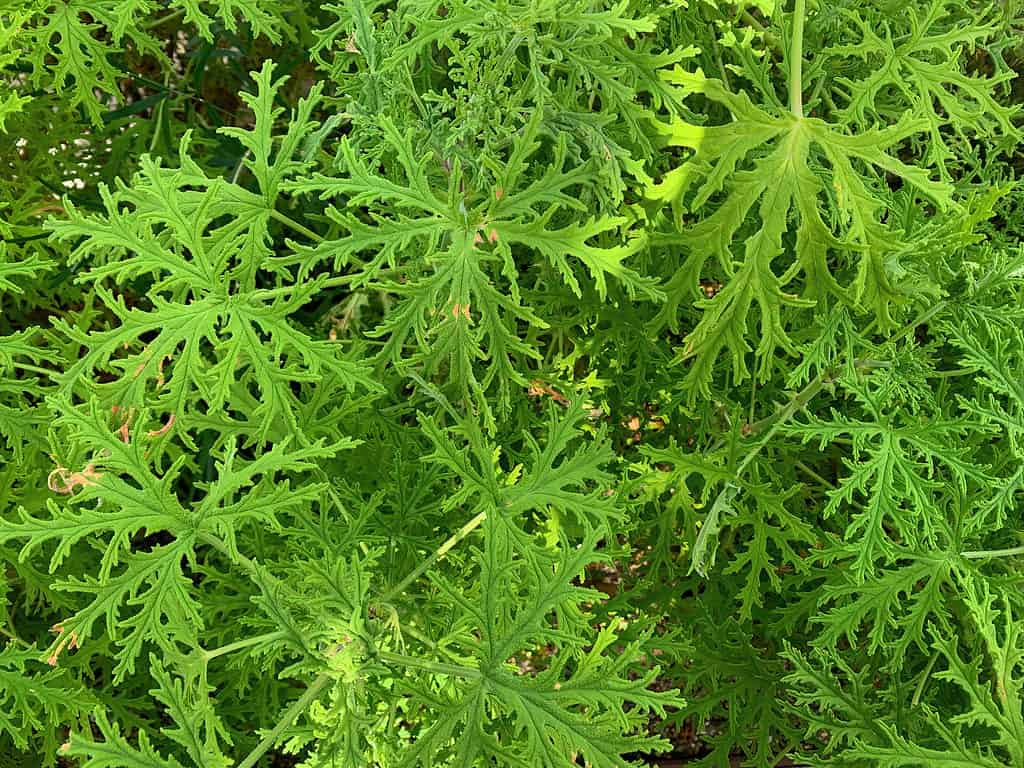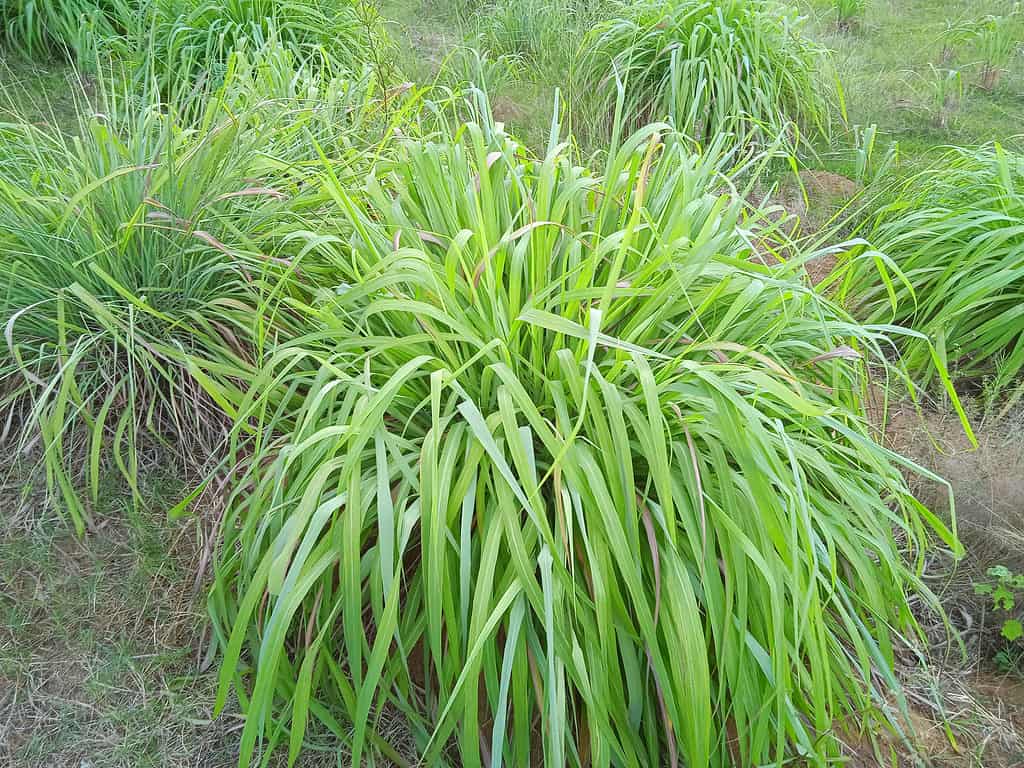Citronella has the reputation of being one of the most effective natural mosquito repellents in the world. That’s why many people choose to plant this aromatic beauty around their homes during the summer months. However, citronella has become so synonymous with lemon aroma that more than one plant bears the name.
Citronella plants and citronella grass are two entirely different plants. Here are the key differences, so you know what you’re getting.
Comparing Citronella Plant vs. Citronella Grass
| Citronella Plant | Citronella Grass | |
|---|---|---|
| Classification | Pelargonium citrosum, Pelargonium citronellum | Cymbopogon nardus |
| Alternative Names | Citronella geranium, citrosa geranium | Ceylon Citronella |
| Origin | South Africa | South Asia |
| Description | Bushy evergreen shrub with green palmately lobed leaves. Flowers are large and soft pink with dark purple markings. Grow up to 2 feet tall and 3 feet wide. Leaves emit a lemony aroma when disturbed. | Tall grass reaching up to 6 feet tall and 6 feet wide with wide blades. The grass is light brown to light green and emits a lemony aroma. |
| Uses | Marketed as a mosquito and pest-repellant plant. | Marketed as a mosquito and pest-repellant plant. |
| Growth Tips | Plant in well-draining soil in full sun to partial shade. Will grow as a perennial in USDA Zones 10-12 and an annual elsewhere. Water infrequently, letting soil become completely dry between. Prefers a humid environment. | Plant in well-draining soil in full sun to partial shade in USDA Zones 10-12. Water frequently, maintaining moisture and humidity. |
| Interesting Features | Citronella plants are a type of geranium. They were misclassified until 1983. | Citronella grass is the primary supply of citronella oil. It’s derived through a labor-intensive process. |
Citronella Plant vs. Citronella Grass: Key Differences
The citronella plant and citronella grass are two very different plants. The citronella plant is a blooming flower in the geranium family, while citronella grass is an ornamental grass with no blooming cycle.
Different parts of the world host these plants: the citronella flowering plant thrives in South Africa, while South Asia is home to the native citronella grass.
Both plants emit a lemony scent, but citronella grass produces true citronella oil. The name of the citronella plant comes from the grass.

The citronella plant is a blooming flower in the geranium family.
©iStock.com/Akchamczuk
Citronella Plant vs. Citronella Grass: Classification
The citronella plant is classified as Pelargonium citrosum. The genus Pelargonium consists of 280 flowering plants and succulents that fall into the geranium family. It’s sometimes misclassified as Pelargonium citronella. “Citrosum” is Latin for citrus.
Citronella grass is classified as Cymbopogon nardus. Cymbopogon is a genus of tropical grasses, which citronella grass shares with lemon grass. Citronella grass falls into the Poaceae family of grasses, which it shares with barley, wheat, and rice.
Beyond being parts of the plant kingdom, the citronella plant and citronella grass are unrelated.

Citronella grass is the primary supply of citronella oil.
©iStock.com/Hermawan
Citronella Plant vs. Citronella Grass: Origin
The citronella plant originates in South Africa. The plant was mistakenly classified as Pelargonium scabrum due to its similar features until 1983.
Initially, many believed this cultivar was a hybrid of citronella grass and geraniums, but research has since disproven that theory.
Citronella grass grows in South Asia, particularly in Sri Lanka, India, Sudan, and Vietnam. It also grows in South Africa, though it’s not native to that environment.
Citronella Plant vs. Citronella Grass: Description
The citronella plant is a full, evergreen shrub with green palmately lobed (maple leaf-shaped) leaves. Its flowers are a delicate pink with dark purple markings. This is similar to the Pelargonium scabrum, which led to initial confusion about this species. The citronella plant grows up to two feet tall and three feet wide, emitting a lemony aroma when the leaves are rubbed.
Citronella grass is a tall, wide-bladed grass reaching up to six feet tall and wide. The grass is light brown to light green and also emits a lemon scent.

The citronella plant is a full, evergreen shrub with green maple leaf shaped leaves.
©iStock.com/PotatoeHead
Citronella Plant vs. Citronella Grass: Uses
Both the citronella plant and citronella grass are marketed as mosquito repellents. However, studies exploring the efficacy of the citronella plant as a natural deterrent have shown this belief to be false. There was no notable difference between people who used the citronella plant or went without in terms of mosquito bites.
Citronella grass is the primary source of citronella essential oil, which is still believed to be effective against mosquitos. Those looking for an essential oil or natural plant for this purpose should use Cymbopogon nardus.

Both the citronella plant and citronella grass (pictured) are marketed as mosquito repellents. However, only the latter is effective.
©iStock.com/Siti Aisah
Citronella Plant vs. Citronella Grass: Growth Tips
Citronella plants are tropical and thrive in hot, humid environments. Plant your citronella plant seeds or transplants in well-draining soil in full sun to partial shade. This plant will come back each year as a perennial in USDA Zones 10-12 and an annual elsewhere. Water infrequently, letting soil become completely dry between. If the citronella plant is underwatered, its leaves will start to shrivel and brown. However, watering it will bring it back around.
Citronella grass also does best in a hot environment and thrives in USDA Zones 10-12. Plant in well-draining soil in full sun to partial shade. Water frequently, maintaining constant soil moisture and humidity.
Both of these plants can be potted as annuals and overwintered indoors.
The photo featured at the top of this post is ©
Sources
- JSTOR, Available here: https://plants.jstor.org/stable/10.5555/al.ap.specimen.k000417326
- ScienceDirect, Available here: https://www.sciencedirect.com/science/article/pii/S0022461816301486
- Taylor & Francis Online, Available here: https://www.tandfonline.com/doi/abs/10.1080/10412905.1993.9698214
- National Library of Medicine, Available here: https://pubmed.ncbi.nlm.nih.gov/30019646/
Thank you for reading! Have some feedback for us? Contact the AZ Animals editorial team.






